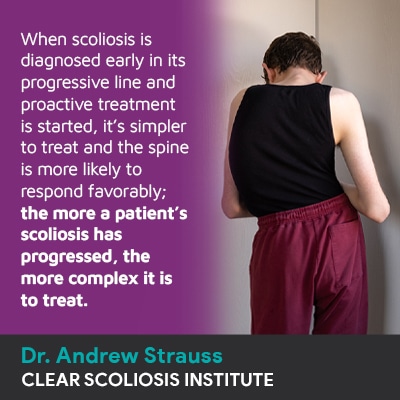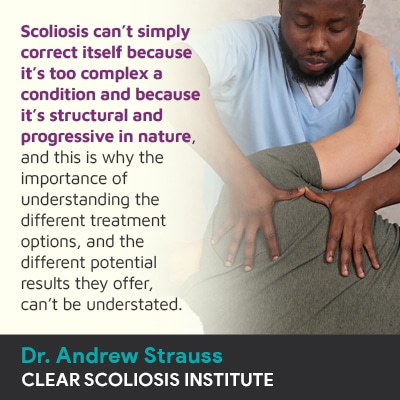
There are a number of spinal conditions that cause the development of unhealthy curves, but structural spinal conditions involve abnormalities within the spine itself, and this involves its vertebrae (bones). Continue reading to learn why scoliosis can’t simply correct itself, along with what progression means.
As a progressive structural spinal condition, the nature of scoliosis is to get worse over time, and while this means the condition is incurable, it can be highly treatable; however, scoliosis will neither go away, nor fix itself; only proactive treatment can do that.
In order to better understand the complex nature of scoliosis, let’s start with how scoliosis is diagnosed.
In order to reach a diagnosis of scoliosis, certain condition characteristics have to be in place, and the effects of scoliosis aren’t always overt and easy to detect.
Scoliosis involves the development of an unhealthy and unnatural sideways spinal curve that introduces a lot of uneven forces to the spine and body; in order to be considered a true scoliotic curve, there also has to be a rotational component.
So a scoliotic spine doesn’t just bend unnaturally, it also twists, and this makes scoliosis a complex 3-dimensional spinal condition.
In addition, there is also the curve-size requirement of a minimum Cobb angle measurement of at least 10 degrees.
A patient’s Cobb angle is taken during X-ray and tells me how far out of alignment the spine is, and the higher the Cobb angle, the more tilted the vertebrae are at the curve’s top and bottom, and the further away from the midline of the body is the middle of the curve and the more severe the condition:
Now, as a progressive condition, scoliosis isn’t static, meaning it’s going to change, so how severe a patient’s scoliosis is at the time of diagnosis doesn’t mean that’s where it will stay, especially if left untreated.

So does scoliosis ever correct itself? No, it can’t, and that is why proactive treatment is needed to work towards counteracting the condition’s progressive nature; leaving scoliosis untreated can mean allowing the scoliotic curve to progress unimpeded, and this can be dangerous, particularly when treating children who have not yet reached skeletal maturity.
We don’t always know what causes scoliosis to develop, but we do understand what triggers its progression, and that’s growth, so children, particularly very young children and adolescents going through puberty, are at risk for rapid-phase progression due to the triggering effect of growth spurts.
As scoliosis progresses, its effects are likely to become more noticeable; in children, the main symptom of scoliosis is postural deviation, and in adults, it’s that same postural deviation along with pain (back pain and pain that radiates into the extremities due to nerve compression).
Scoliosis doesn’t become a compressive condition until skeletal maturity has been reached, and compression of the spine and its surrounding muscle and nerves is the main cause of condition-related pain; this is why children don’t commonly find their scoliosis painful, and this is also why early detection of childhood scoliosis isn’t always easy.
When scoliosis is diagnosed early in its progressive line, and proactive treatment is started, it’s simpler to treat and the spine is more likely to respond with significant curve reductions; the more a patient’s scoliosis has progressed, the more complex it is to treat.
When a spinal condition is postural, it’s caused by chronic poor posture introducing adverse spinal tension; if an unnatural spinal curve is caused by poor body positioning, a change in posture and/or body position can reduce the curve.
In cases of structural spinal conditions like scoliosis, because their underlying nature is structural, no change in posture or position can reduce the curve, and in order to be treated effectively, a change needs to be made on a structural level, and this means to the bones themselves, along with the supporting ligaments and muscles.
When a person is diagnosed with scoliosis, because it’s a progressive and incurable condition, the choice of how to treat it can have far-reaching effects.
The two main treatment approaches are traditional and conservative; traditional treatment focuses on a passive watch-and-wait approach that tends to funnel patients towards spinal fusion surgery, while conservative treatment is proactive and works towards impacting conditions, first and foremost, on a structural level.
When scoliosis progresses, the scoliotic curve gets larger and more rigid, making it less responsive to treatment, and in addition, increasing spinal rigidity can reduce a patient’s ability to perform certain therapeutic exercises with corrective potential.
The longer scoliosis is left to progress, the more it’s going to affect the body, and these effects only get harder to improve/reverse the longer they’ve been established.
Here at the CLEAR Scoliosis Institute, our approach is proactive so we want to start treatment immediately; waiting to see whether a progressive condition is going to progress is a waste of valuable treatment time.
Particularly when treating the condition’s most-prevalent type, adolescent idiopathic scoliosis diagnosed between the ages of 10 and 18, progression can be fast, and once that happens, it’s far more difficult to try and reverse than it is to try and proactively prevent.

Chiropractic care involves a number of techniques and low-force adjustments that work towards impacting the condition on a structural level by realigning the spine; this involves focusing on the underlying neurological causes along with the structural components of the condition.
Once I see structural results in the form of a curvature reduction, this means the condition’s uneven forces are also being reduced; I can then focus on increasing core strength through various scoliosis-specific-therapies and the use of scoliosis-specific exercises (SSEs) that can strengthen the back’s supportive muscles, address any related muscle imbalance, improve posture, and certain SSEs are also known to stimulate specific areas of the brain to re-train the body’s postural mechanisms to stabilize the corrections.
Particularly when treating adolescent idiopathic scoliosis, corrective bracing may be helpful by slowly lifting and de-rotating the spine into an aligned position. 3D bracing along with chiropractic adjustments and scoliosis-specific exercises and scoliosis-specific therapies that patients can easily perform from home further stabilize the scoliotic spine.
Scoliosis can’t simply correct itself because it’s too complex a condition and because it’s structural and progressive in nature, and this is why the importance of understanding the different treatment options, and the different potential results they offer, can’t be understated.
As a progressive condition, the very nature of scoliosis is to get worse over time, so it’s virtually guaranteed to do so, and this is why leaving scoliosis alone, in the hopes of it correcting itself, can be so dangerous.
Scoliosis affects all ages, and there are multiple different condition types, but adolescent idiopathic scoliosis is the most common form, and being proactive with treatment is particularly important with this type because growth spurts can trigger rapid progression.
When it comes to whether or not scoliosis can be reversed, it’s more accurate to say it can be reduced, which means achieving a reduction in the scoliosis along with restoring as much of the spine’s healthy curves (those seen when the spine is viewed from the side) as possible.
When a scoliotic curve is reduced, this means its underlying structural and neurologic nature has been addressed by treating the whole condition, much more than only the spinal bones themselves.
If I can help a patient increase the strength of the spine’s surrounding muscles through scoliosis-specific exercises, along with a variety of condition-specific therapies, this helps the spine maintain its newly scoliosis-reduced posture.
Scoliosis can’t be fully reversed because as a progressive condition, it’s virtually guaranteed to get worse eventually, and while there are no treatment guarantees, when treated proactively, scoliosis can be improved and treated in such a way that the spine’s strength and function are preserved.

CLEAR provides a unique and innovative way of understanding scoliosis. Sign up to receive facts and information you won’t find anywhere else.
